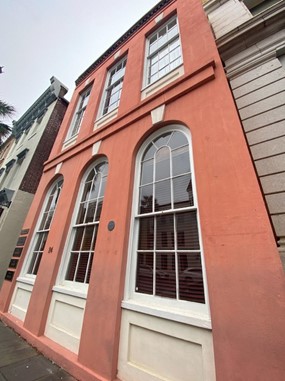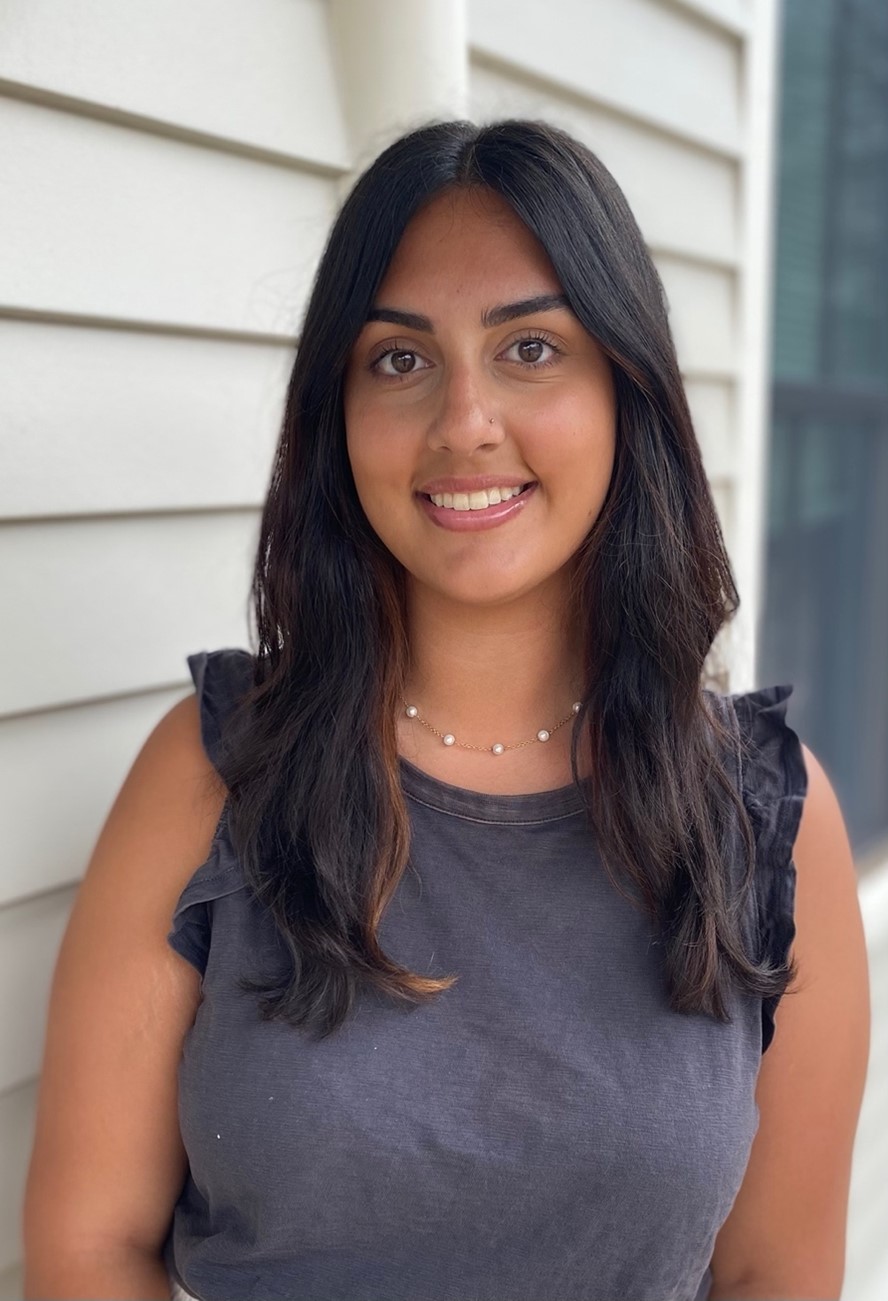» Public Memory of the Domestic Slave Trade in Charleston, South Carolina Street by Lauren Davila
South Carolina’s oldest business district stands in downtown Charleston on Broad Street, just steps from the Atlantic Ocean. It intersects with the city’s other historically significant thoroughfares, East Bay Street, Meeting Street, and State Street. If one were to take a stroll down Broad Street today, they would pass restaurants, art galleries, coffee shops, and offices, all housed in beautiful historic buildings that charm both locals and tourists alike. Stand at the intersection of Broad and State Streets and look North and you’ll observe one of Charleston’s most scenic views. Along the tree lined street is The People’s Building standing to the left, and to the right is the South Carolina National Bank of Charleston, one of the city’s most important buildings since its construction in 1871.1To the casual observer, there are few clues that reveal what this space looked like in the 1830s and 1840s when Charleston was a prominent hub of the domestic slave trade. One of Charleston’s most prominent slave-trading firms was Jervey, Blake and Waring, later renamed Jervey, Waring, and White. Opening in 1828, they stood at 20 Broad Street (today known as 24 Broad Street) for over a decade. The domestic slave trade was Charleston’s most lucrative business. The partners of the slave-trading firm Jervey, Waring, and White, for example, facilitated the largest individual sale of enslaved people in the country’s history. This sale of 600 enslaved people elevated the slave-trading firm in wealth and status.2 Although slave traders were in the business of buying and selling victims of human trafficking, they were upheld by their contemporaries as honorable men of society. They were members of societies and clubs, held positions at banks, in the courts, and in the city government, and in some cases, even became chairmen of the Vestry in their churches.3

Their ties to slavery, although extremely important to the history of Charleston and the domestic slave trade, have been obscured by the passage of time along with the repurposing of the building where their slave-trading firm operated. Exploring how James Jervey, Morton A. Waring, John H. Blake, and Alonzo J. White, and the space connected to them have been remembered, as well as how their brutality against enslaved people has been largely erased from public memory and the physical landscape (though it greatly contributed to wealth, infrastructure, and legacy they left behind) allows for better understanding of history. Although the former office building does not presently represent what it initially stood for, publicly marking and remembering its role in the domestic slave trade and its significance as an engine of economic prosperity, political power, and white supremacy would provide both residents and tourists who traverse the city with a deeper understanding of the landscape they occupy.
On February 24, 1835, Jervey, Waring and White posted an advertisement in the Charleston Courier that read, “This day, the 24 instant, and the day following, at the North Side of the Custom-House, at 11 o’clock, will be sold, a very valuable gang of negroes, accustomed to the culture of rice; consisting of six hundred.”4Charleston had never seen a sale of this many enslaved African men and women (and presumably children) at one time before. Prior, the largest sale outside the Customs House, also facilitated by Jervey, Waring, and White’s firm, had been for 300 people. The sale of 600 enslaved people in a public area of Charleston near banks, coffee houses, and storefronts, would have brought massive amounts of spectators and prospective buyers to an already small and cramped space that was the North side of the Customs House.
It is not known where Jervey, Waring, and White acquired these enslaved people, or where they were trafficked after their sale in Charleston, as no receipts or journals survive from these men during this time period. From the title of the advertisement, it is known that the enslaved were taken from a large estate as part of an estate sale. These people, considered property, were to be sold, along with five plantations and two plots of land. Slave traders conducting business across the Deep South likely came to Charleston to purchase these enslaved people in order to sell them across the deeper southern states. This sale would have forced the separation of hundreds of people from their families and broken-down strong community bonds. Some may have been forced to walk hundreds of miles to their next destination.
Following the number of enslaved people to be sold, the advertisement continued, “among them are Drivers, Carpenters, Coopers, and Boatmen…Conditions—One third cash; or the balance, a credit of one, two, and three years secured by bond, mortgage, and approved personal security; interest from day of sale, payable annually.”5The statement of these specific assigned jobs means the enslaved people mentioned were highly valuable in terms of abilities. Enslaved people who were knowledgeable about the production of rice crops in Charleston were highly valued due to the prevalence of rice cultivation in rural areas outside of the city. In Charleston, boatmen, coopers, and carpenters were also sought after for their abilities. This group of 600 enslaved people represented not only a large financial gain for Jervey, Waring, and White but potential profits for those enslavers who purchased them.
Jervey, Waring, and White eventually dissolved their firm in 1840 for reasons unknown, yet the men stayed in the slave-trading business.6Jervey and one of his sons, Lewis Jervey, continued in the slave-trading business out of the building directly next to State Bank on Broad Street under the name “Jervey and Son” until Jervey Sr.’s death in 1845.7 Lewis continued the family business until the end of the slave trade in Charleston.8Waring and White entered into a partnership in the same year Jervey and his son went into business with each other. Their partnership did not appear to last long, as only around a dozen advertisements exist for the pair before individual advertisements for the men began appearing in the newspaper that ended by 1841.

Business continued as usual after the Civil War and the end of the slave trade, meaning these sites of the trade did not stand unused for long. Although their firm eventually closed, business continued to be conducted in this space, and over time the building was bought by Charleston Savings Institution in 1885, followed by its purchase and use by Exchange Banking and Trust Company in 1922.9In 1947, 24 Broad Street was bought by American Mutual Fire Insurance Company who sold it to Theodore D. Maybank in 1955.10 Since 1989 when it was purchased by the current owners, it has been used as various offices for different law firms in Charleston. Because Jervey, Waring, and White were considered businessmen and not necessarily slave traders, the owners occupying these spaces were able to move forward and ignore its slave-trading past. The end of the slave trade did not bring shame or guilt to these former slave-trading men, because after fighting a war to protect the institution of slavery, one can presume, there was nothing they felt they should have been ashamed for. The South’s lack of remorse for slavery and the continued commitment to the political, social, and economic subjugation of Black people meant there was no reason to memorialize an institution that had been legal for centuries and for which they had no perceived ethical conflicts. Despite Charleston’s historic commitment to the preservation and commemoration of its historical and architectural landscape, over time, 24 Broad Street’s significance as a major site of slave-trading was forgotten with each business that passed through its walls.
For more information about slave trading and sites of the domestic slave trade in Charleston, visit this online walking tour of Broad and State Streets.
Sources
- “South Carolina Bank of Charleston (U.S. National Park Service),” National Parks Service (U.S. Department of the Interior), https://www.nps.gov/places/south-carolina-bank-of-charleston.htm.
- Anne C. Bailey, The Weeping Time: Memory and the Largest Slave Auction In American History (New York: Cambridge University Press, 2017).
- “From Columbia.” Charleston Courier, December 13, 1831; “At the Anniversary Meeting.” Charleston Courier, January 16, 1834; “Death of James Jervey, esq.” Charleston Courier, April 4, 1845.
- “Estate Sale,” Charleston Courier, February 24, 1835.
- “Estate Sale,” Charleston Courier, February 24, 1835.
- “The Co-Partnership,” Charleston Courier, July 10, 1840.
- “At Private Sale,” Charleston Courier, April 17, 1845.
- “Notice,” Charleston Courier, April 29, 1845
- Charleston County, South Carolina, Register of Deeds, Book P31 Page 058.
- Charleston County, South Carolina, Register of Deeds, Book P47 Page 302; Charleston County, South Carolina Register of Deeds, Book A60 Page 467.
Image Credit
- Photo looking north up State Street, 2023. Photo taken by author.
- Photo of present day 24 Broad Street, 2023. Photo taken by author.
Author

Lauren Davila is a Public History master’s candidate at the College of Charleston, a recipient of the Karen Chambers Fellowship and served as co-president of the Graduate Historical Society.
